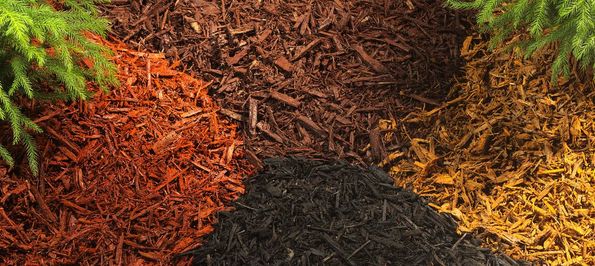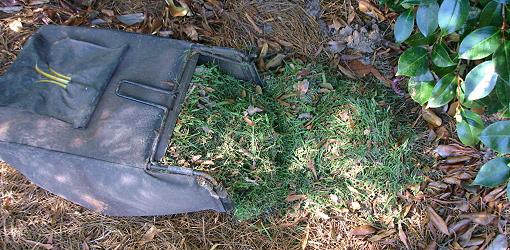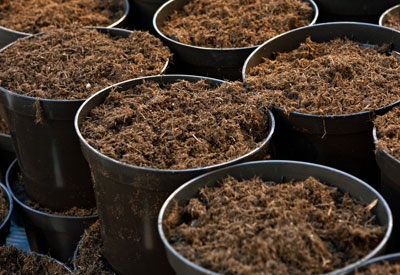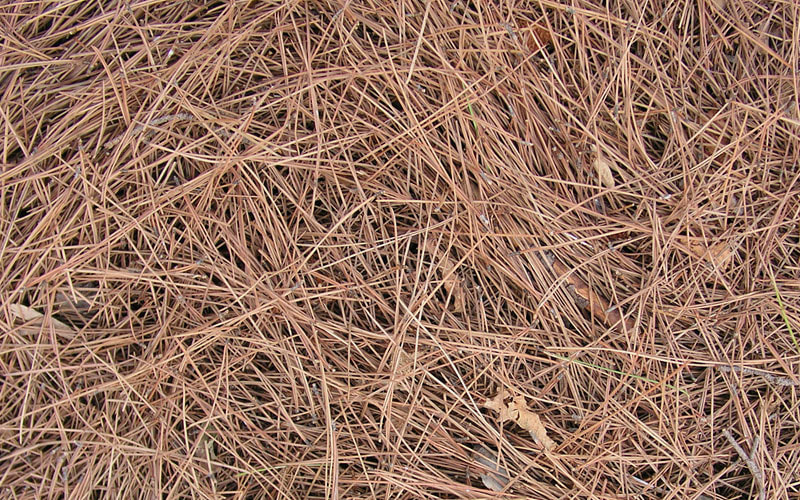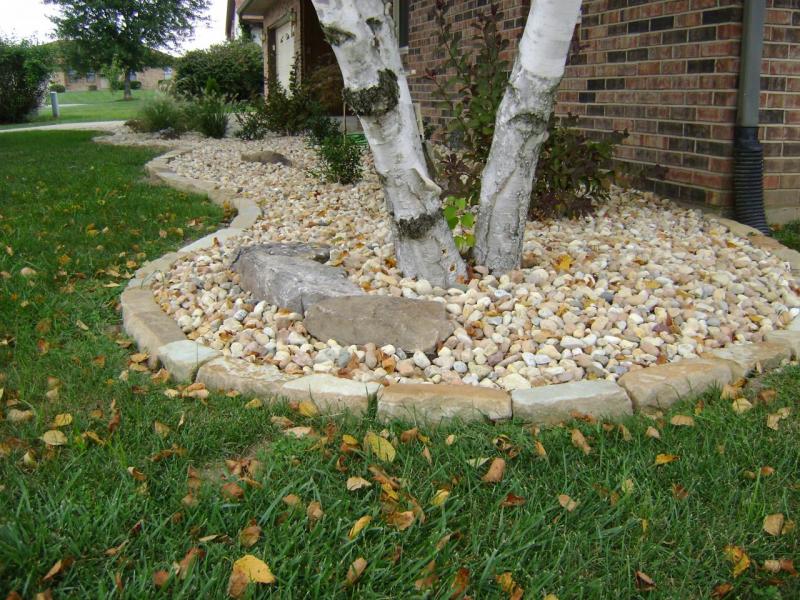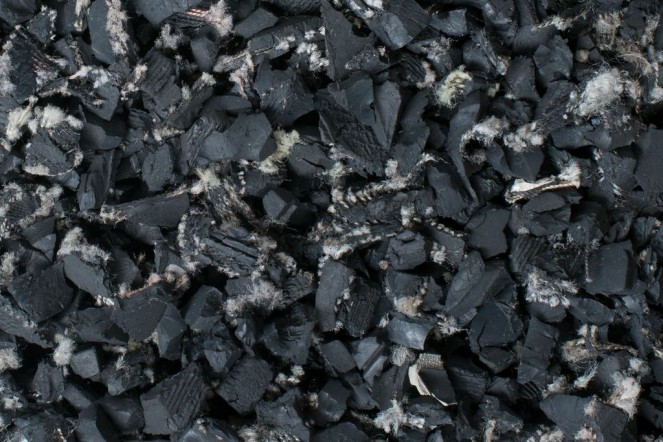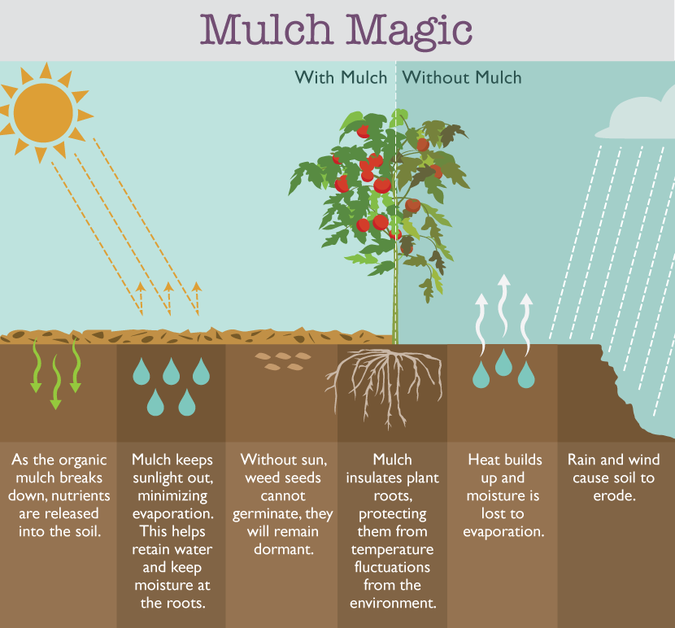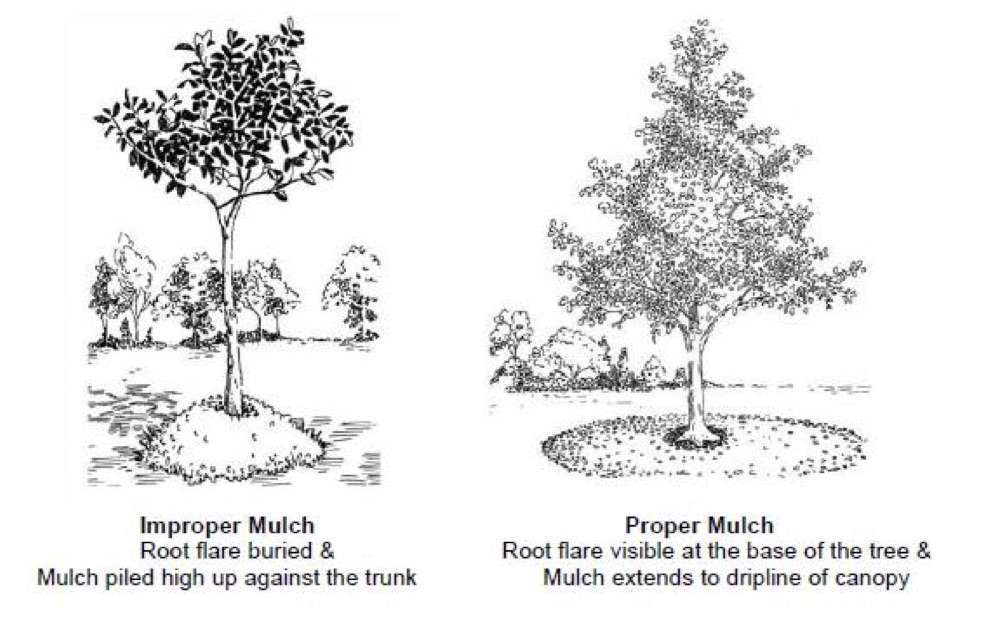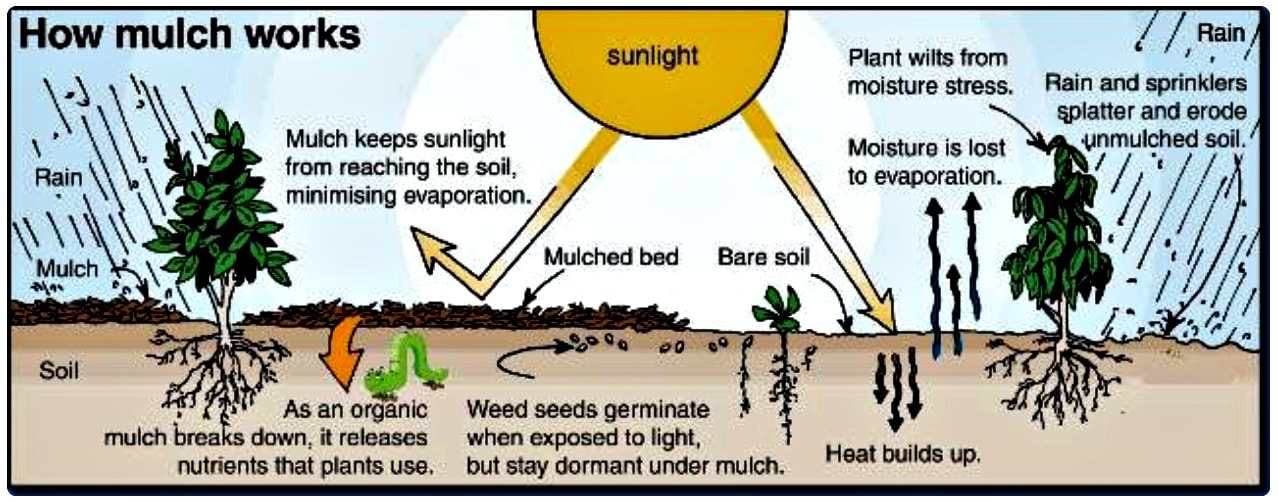What is Mulch?
Mulch is a common component of residential, public, and natural planting used as a ground cover that provides aesthetic appeal and benefits plant health. However, different mulches affect the environment in specific ways so we must ask ourselves, what qualifies as mulch and how do you implement it in a landscape for maximum benefits?
|
There are many benefits to mulching. Mulch, which is an organic or inorganic protective covering spread across the soil, can help maintain soil temperatures, reduce evaporation, control weeds and erosion, and enrich the soil. (1) Mulches differ from soil amendments which are materials incorporated directly into the soil layers whereas mulches are laid over the soil surface. (2) The following review of mulches will identify different types of mulches, how and when to apply mulch, the affect of mulch on plants, and other considerations one should make when selecting a mulch for a landscape.
|
"Mulch helps maintain soil temperature, reduce evaporation, control weeds and erosion and enrich the soil."Trees are commonly over-mulched, with the material piled against the base of the tree. This 'volcano mulching' surrounds the trunk causing a build-up of moisture which encourages decay and creates an environment suitable for the growth of insects, pests, and disease. (3) For mulch to be correctly applied in a landscape it should not come in contact with the trunk at all. Mulch should pull away from the tree, extending to the drip line of the branches, or generally extending past a 4-5 foot diameter around the tree. (3) For many plantings, it is common to use a medium to coarse textured mulch, and it should be applied to a depth of 3-4 inches for maximum benefit. (4) But for each landscape, the types of mulch, how much, how deeply it is applied, as well as how long it is applied will cause variations in the impacts of mulch on the plant and landscape. This is why understanding how to implement mulch in a landscape is important.
|
Types of Mulch
Mulch studies began to pop-up around the late 1930s and as research picked up throughout the 1900s more and more varieties of mulch have been tested in landscapes. (2) There are two basic categories of mulches: organic and inorganic. When selecting a mulch consider cost, quantity, appearance, quality, durability, and the environmental impacts.
|
Organic Mulches
Organic mulches are created from materials that were once alive and they decompose over time which improves soil structure by keeping soil loose. Loose soil improves root growth, water infiltration, and creates an environment suitable for beneficial soil organisms. Organic mulch can also benefit a landscape by increasing water holding capacity and increasing nutrient additions to the soil. Organic mulches are often byproducts of other industries and can be a sustainable option in reusing waste materials. (4) |
Inorganic Mulches
Inorganic mulches are often implemented in landscapes as a barrier to suppress the growth of weeds. Other times they are used for aesthetic reasons. They do not decompose readily and can stay in an environment for an indefinite period of time. Inorganic mulches have little effect on soil quality because they do not release nutrients into the soil. Different types of inorganic mulch also absorb or reflect heat which influences soil temperature and can affect plant health. (4) |
|
Mulch Type
Bark Municipal Waste Cocoa Bean Hulls Grass Clippings Leaf Mulch Animal Manure Peat Moss Pine Needles Newspaper Plastic Film Landscape Fabric Stone Rubber |
Organic/Inorganic
Organic Organic Organic Organic Organic Organic Organic Organic Organic Inorganic Inorganic Inorganic Inorganic |
Source
Byproduct of Lumber Industries Byproduct of Utility Companies or Arborists Byproduct of Chocolate Industry Byproduct of Mowing Byproduct of Trees Byproduct of Animals Sourced from Bog Plants Byproduct of Coniferous Trees Recycled from Print Manufactured Manufactured Recycled from Concrete or Manufactured Manufactured or Recycled from Tires |
Benefit
Available in Various Colors Free, Local Mulch Pleasant Smelling Free, Sustainable Mulch Free, Sustainable Mulch Good Source of Nutrients Increased Water Absorption Free, Sustainable Mulch Free, Sustainable Mulch Available in Various Colors Available in Various Colors, Porous Aesthetically Pleasing, Various Options Various Options |
Downside
Decomposes Slowly Decomposes Slowly Dangerous if Ingested by Pets Requires Multiple Applications in Thin Layers Can be Infected with Fungal and Bacterial Disease (Compost Prior) High Salinity (Compost Prior) Tendency for Compaction, Dries Out Quickly Increases Soil Acidity Lightweight Impermeable, Deteriorates with Sun Exposure Replaced More Often Does Not Retain Moisture, Excessive Heat Increased Soil Toxicity, Does Not Decompose |
Application
2-4" Depth 2-4" Depth 1" Depth, Watered to Hold in Place 1" Depth, Compost Before, Mix with Other Materials 2" Depth, Compost Before 2-4" Depth, Compost Before 2-4" Depth, Mix with Other Materials, Not a Top Layer 2-4" Depth 2-3 Layers, Cover with Organic Material to Hold in Place Cut to Fit Cut to Fit Fill Around Plants Fill Around Plants |
Table 1: Analysis of Organic/Inorganic Mulches (4) (6)
Gallery: Types of Mulches
(Figures 3-15)
(Figures 3-15)
How & When to Apply Mulch
Mulch acts as a barrier between the soil and the environment mediating effects of rain, wind, heat, and cold on soil and the roots that reside there. (2) For this reason, it is important to apply the right type of mulch during the right times of year. Maintaining optimal soil temperature is very important in the establishment and protection of roots against heat and cold. (7) In the spring, mulched soil tends to warm up more slowly and in the fall it cools down more slowly than unmulched soil. (3) Preparing for winter is very important and application of mulch should take place after the soil freezes but before the coldest temperature hits. (3) Mulching before winterization also protects plants from being heaved out of the soil from freeze/thaw cycles which can expose root systems and damage or kill them. (4) Good materials to use are loose and won't compact under weight of snow such as straw or hay.
As temperatures start to warm up in the spring, another layer of mulch can be applied if needed. Too early in the season and the mulch will keep temperatures cool and wet. (4) Cooler temperatures slow tree growth and wet mulch can breed fungal and bacterial disease. (4) It is important to not over-mulch as this can lead to increased moisture resulting in increased numbers of bacteria, pests, and insects. (3) Mulch should only be applied as needed to its original depth of around 3-4" for medium to coarse textured mulch and kept 1-2" away from the trunk to prevent excess moisture. Mulch should extend to the drip line of branches or generally past a 3-4' diameter. (3) Application of too much mulch can result in root compaction and root suffocation. (2)
It is important to make sure mulch is not too wet as it can attract unwanted insects and organisms. If mold or fungus develops from excessive moisture it can be raked off and the mulch should be turned to increase air circulation as well as dry out the soil. (4)
Mulch Effect on Plants
There have been many studies on the effect of mulch in landscapes and the benefits it provides plants. The protective layer of material applied to the surface of soil helps to prevent erosion and compaction which contribute to root stress. (2) Mulch helps conserve soil moisture by reducing evaporation and increasing percolation and retention. (2) Another benefit of mulch is its regulation of soil temperature by creating a barrier between the soil and air. (2) Soil nutrition is also greatly affected by mulch and it can have beneficial or harmful results. (2) The application of mulch can help plants become established in a landscape and improve plant growth. (11) It also plays a role in disease prevention while reducing the need for pesticide application. (2) Finally, studies have shown that mulches play a role in reduction of weeds. (8) Once again recognizing what performance benefits a planting needs plays a vital role in the selection of a mulch for a landscape and this section will cover what role different mulches play in these performance aspects.
|
Soil Erosion & Compaction:
Erosion and compaction are common in urban landscapes and bare soil is especially susceptible to such ailments. Laying down a layer of mulch protects soil from the elements (precipitation, wind) as well as foot traffic which can cause erosion and compaction of soil. (2) Especially on slopes, application of mulch, particularly organic mulch, helps prevent soil loss. One study showed that just a .6" layer of straw reduced soil erosion by 86%. (12) Adding an erosion net increased the reduction of erosion to 95% in a bare soil forest plantation. (13) Mulch also reduces compaction from both pedestrian traffic and rainfall by dispersing the force from impact. This is beneficial to trees because it maintains soil aggregation & porosity if applied prior to compaction. (2) If mulch is applied after compaction it can only maintain soil structure and cannot change or reverse bulk density of the soil. (2) |
Soil erosion causes mineral nutrient loss which negatively impacts tree growth. (5)Root respiration is reduced by compaction. O2 cannot enter the soil and CO2 cannot exit the soil when compacted. Compaction also reduces water infiltration. (5) |
|
Soil Moisture:
The benefit of reduced compaction from mulching also maintains a soil's ability to absorb rainfall or irrigation. (2) With the exception of competitive organic mulches like turf, most mulch applications increase a soil's water retention comparatively to bare soil. (2) Permeable mulch increases soil percolation and retention while decreasing water loss through evaporation & runoff. (10) The same study of application of .6" of straw reduced runoff by 43%. (12) These reductions have also been seen in other organic mulches. Inorganic mulches have seen less success in benefiting soil moisture. Plastics because of their impermeable surface limit water infiltration which reduces recharge and can increase runoff/erosion. (3) When choosing a mulch to improve soil moisture avoid plastics, geo-textiles, sheet mulches, fine-textured mulches, and mulches with waxy-components because overtime they dry out soil even if they initially increase water retention because of decreased evaporation. (2) Instead opt for permeable, organic mulches which have proved more successful in increasing soil moisture conditions. Choosing these mulches will ultimately reduce irrigation requirements and protect the plant from drought stress. |
Water has four main functions in plants. Water is important in maintaining cell turgidity for structure and growth. Water is the medium for transporting nutrients and compounds through the plant. Water makes up most of the living protoplasm in cells. Finally it is used in chemical processes such as photosynthesis and transpiration which protects against temperature fluctuations. (5) |
|
Soil Temperature:
Mulch provides a barrier between the soil and the air helping to maintain an optimum temperature for plant growth.(2) This means soils can be kept cooler in extreme heat and warmer in extreme cold, protecting the delicate fine roots of plants from dying off and minimizing energy expended in generating new fine roots. (14) This performance benefit of mulch becomes increasingly important in cold climates because it allows for better root growth and establishment of new transplants that need time to develop deeper root systems. (2) Once again coarse and organic mulches have proved more efficient than fine or inorganic mulches in this performance area. Also applying thicker layers proves more effective in temperature moderation unless it is using finely textured mulch which inhibits water and gas transfer. (5) Plastics can exacerbate temperature conditions by absorbing or reflecting heat which may be useful if trying to kill pests through soil solarization or improving fruit maturation, but for most landscapes coarse, organic mulches are ideal for moderating temperature change. (15) |
Photosynthesis is affected by soil temperature. The rate of CO2 uptake decreases with low temperatures. Increased soil temperature increases root respiration and mineral uptake. (5)Low soil temperature increases resistance to water uptake by roots. (5) |
|
Soil Nutrition:
Mulches effect on soil nutrition varies greatly depending on the type of mulch, soil chemistry, and plant nutritional need. (2) Generally, inorganic mulches do not have much effect because of their slow decomposition. (7) The most nutrient rich mulches are animal manures which release nutrients at higher rates than other organic mulches. (4) These should be applied sparingly so plants can uptake minerals at a normal rate and reduce excess mineral damage to soil organisms, plants, and watersheds. (16) Some living mulches compete for resources with a plant and applications of these are most beneficial where soil fertility is too high. (2) Low nutrient mulches can improve ecosystems when used correctly. (17) Uncomposted bark or straw decreased nitrogen pollution in watershed, pushed native plants to compete more effectively with invasive species, and have increased soil nutrients and foliage. (2) |
Macronutrients are needed in large quantities by a plant. These include nitrogen (N), phosphorus (P), potassium (K), calcium (Ca), magnesium (Mg), and sulfur (S). (5)Microelements are needed in much smaller quantities and these are Iron (Fe), Manganese (Mn), Zinc (Zn), Copper (Cu), Boron (B), Molybdenum (Mo), Chlorine (Cl), and Nickel (Ni). (5) |
|
Plant Establishment & Growth:
Many studies have been done on mulches effect on plant establishment and growth. First they have shown to improve seed germination and seedling survival. (2) Organic mulches have proved more successful than inorganic mulches in this aspect and deeper plots of mulch help to prevent weed emergence. (18) Root establishment is also improved through water retention as well as weed prevention which leaves space for root growth that helps stabilize the plant. (2) Organic mulches perform better plastics or living mulches. Inorganic mulches encourage root growth on top of the mulch layer because of water availability and once the mulch is removed injures the respective plant. Landscape fabrics encourage root growth and can greatly damage root systems once removed. (2) Living mulches compete with roots of new plants and increase mortality. (2) Studies have shown a 67% increase in height, stem/stem diameter, leaf size/number, and in flower/fruit/seed production in mulched soil compared to bare soil. (19) |
"Organic mulches perform better plastics or living mulches. Inorganic mulches encourage root growth on top of the mulch layer because of water availability and once the mulch is removed injures the respective plant. Landscape fabrics encourage root growth and can greatly damage root systems once removed." |
|
Disease & Pesticide Application:
Disease has been indirectly reduced in plants because of previously listed benefits of mulch that improve overall plant health. These include improvements in soil moisture, temperature, and nutrition. Thujaplicin found in Western red cedar heartwood combats various bacteria and fungi as well as prevents tumors. (2) Healthy microbes found in mulches also contribute to reduced pathogens through competition. (5) This is an example of why organic mulches are more effective at disease prevention than inorganic. But if organic mulches are not composted correctly they can spread disease instead of prevent it. (4) In terms of pesticides, mulches have shown to reduce plant susceptibility to pests because of increased soil health. (2) This is another example of how preliminary mulching can be economically efficient by saving cost spend on herbicides, insecticides, and fungicides. |
When using organic mulches be sure to compost them correctly to prevent the spread of fungal and bacterial disease (7) |
|
Weed Prevention:
Mulches control the growth of weeds in a variety of ways. Mulch prevents weed emergence because it minimizes light, stressing weeds and reducing germination. (2) This does not apply to plastic films which allow light to penetrate the surface of the mulch. (4) Mulch can also act as a temporary barrier that stops weeds from emerging in a landscape. Once again plastics are less successful because weeds can push through the film. (4) Another method of weed control is the leaching of allelopathic chemicals that are found in wood chips. (2) Lastly, competition reduces weeds. Soil health improvements initiated from mulching increases beneficial organisms that compete with weeds in a landscape. (2) Living mulches are another source of competition when the desired plant's roots reside deeper than where competition is taking place. Compost is not effective as a weed control because it produces favorable environment for weeds, coarser and less fertile mulches are more effective especially when applied in thicker layers. (4) |
Coarser and less fertile mulches are more effective in weed prevention especially when applied in thicker layers. (4)Organic mulches block sunlight which initiates weed germination. Most inorganic mulches act as an initial barrier in preventing weed growth. (2) |
Other Considerations
Before implementing mulch in a landscape it should be composted or treated to prevent weed seeds, disease microbes, and insects from entering the soil especially if the mulch has been sitting unused for some time. Many cities have municipal mulch piles where you can get excess mulch for free, which is an economic and sustainable option for landscaping. In considerations of aesthetics, there are hundreds of mulch options varying in size, wight, and color. One can implement changes in mulch appearance to regulate how a landscape is used controlling things like foot-traffic which can cause compaction. (5) Mulching can also protect trees from maintenance damage such as damage from lawn mowers. (6) How a mulch will affect local and global ecosystems is also an important consideration to make. Some synthetic mulches, such as rubber, can leach toxins into the soil while others help to reduce pollutants in the soil. (6) Invasive species used as ground covers should be avoided as well as overusing organic mulches which can nutrient overload a soil. (2) Research should be done before implementation of mulch in a landscape.
References
1. Mulch. Merriam-Webster. [Online] https://www.merriam-webster.com/dictionary/mulch.
2. Impact of Mulches on Landscape Plants and the Environment -- A Review. Chalker-Scott, . 4, December 2007, Vol. 25.
3.. Mulching Trees and Shrubs. The Morton Arboretum. [Online] The Morton Arboretum, 2018. http://www.mortonarb.org/trees-plants/tree-and-plant-advice/horticulture-care/mulching-trees-and-shrubs.
4. Plant Information Fact Sheet: Mulch. Chicago Botanic Garden. [Online] Chicago Botanic Garden. https://www.chicagobotanic.org/sites/default/files/pdf/plantinfo/mulch.pdf.
5. Pallardy, Stephen G. Physiology of Woody Plants. Burlington : Academic Press, 2009.
6. Mulching. Backyard Conservation. [Online] USDA Natural Resources Conservation Service. https://www.nrcs.usda.gov/wps/portal/nrcs/detail/?cid=nrcs143_023585.
7. J.M. Stinson, G.H. Brinen, D.B. McConnell, R.J. Black. Evaluation of landscape mulches. s.l. : Proc. Florida State Hort., 1990.
8. R. Koski, W.R. Jacobi. Tree pathogen survival in chipped wood mulch. s.l. : J. Arboriculture, 2004.
9. Cieko, . Effects of mulch, irrigation, and irrigation get on the establishment of conifer seedlings at Seattle forest restoration sites. s.l. : University of Washington, 2009.
10. Bonnie Appleton, Robert Heins, Stephen Donohue, Gregory Eaton, Dawn Alleman, Jim Williams. Trees and Shrubs for Acid Soils. s.l. : Virginia Cooperative Extension.
11. Jackson, David R. Mulching Landscape Trees. PennState Extension. [Online] April 2018. https://extension.psu.edu/mulching-landscape-trees.
12. Woodburn, H.L. Borst and R. The effect of mulching and methods of cultivation on runoff and erosion from Muskinham silt loam. England : s.n., 1942.
13. Megaham, . Deep-rooted plants for erosion control on granitic road fills in the Idaho Batholith. s.l. : USDA Forest Service Research Paper, 1974.
14. Goulet, . Frost heaving of forest tree seedlings: a review. s.l. : New Forests, 1995.
15. Pellett, M. Litzow and H. Influence of mulch materials on growth of green ash. 1993.
16. U. Niggli, F.P. Weibel, C.A. Potter. Weed control in a perennial crop using an organic mulch. 1988.
17. Allen, T.A. Zink and M.F. The effects of organic amendments on the restoration of a disturbed coastal sage scrub habitat. s.l. : Restoration Ecology, 1998.
18. V.K. Winkel, J.C. Medrano, C. Stanley, M.D. Walo. Effects of gravel mulch on emergence of galleta grass seedlings. s.l. : USDA Forest Service, 1995.
19. Posey, H. Hopp and G.B. Evaluation of cork oak as a new farm tree crop in the southeastern United States. 1942.
2. Impact of Mulches on Landscape Plants and the Environment -- A Review. Chalker-Scott, . 4, December 2007, Vol. 25.
3.. Mulching Trees and Shrubs. The Morton Arboretum. [Online] The Morton Arboretum, 2018. http://www.mortonarb.org/trees-plants/tree-and-plant-advice/horticulture-care/mulching-trees-and-shrubs.
4. Plant Information Fact Sheet: Mulch. Chicago Botanic Garden. [Online] Chicago Botanic Garden. https://www.chicagobotanic.org/sites/default/files/pdf/plantinfo/mulch.pdf.
5. Pallardy, Stephen G. Physiology of Woody Plants. Burlington : Academic Press, 2009.
6. Mulching. Backyard Conservation. [Online] USDA Natural Resources Conservation Service. https://www.nrcs.usda.gov/wps/portal/nrcs/detail/?cid=nrcs143_023585.
7. J.M. Stinson, G.H. Brinen, D.B. McConnell, R.J. Black. Evaluation of landscape mulches. s.l. : Proc. Florida State Hort., 1990.
8. R. Koski, W.R. Jacobi. Tree pathogen survival in chipped wood mulch. s.l. : J. Arboriculture, 2004.
9. Cieko, . Effects of mulch, irrigation, and irrigation get on the establishment of conifer seedlings at Seattle forest restoration sites. s.l. : University of Washington, 2009.
10. Bonnie Appleton, Robert Heins, Stephen Donohue, Gregory Eaton, Dawn Alleman, Jim Williams. Trees and Shrubs for Acid Soils. s.l. : Virginia Cooperative Extension.
11. Jackson, David R. Mulching Landscape Trees. PennState Extension. [Online] April 2018. https://extension.psu.edu/mulching-landscape-trees.
12. Woodburn, H.L. Borst and R. The effect of mulching and methods of cultivation on runoff and erosion from Muskinham silt loam. England : s.n., 1942.
13. Megaham, . Deep-rooted plants for erosion control on granitic road fills in the Idaho Batholith. s.l. : USDA Forest Service Research Paper, 1974.
14. Goulet, . Frost heaving of forest tree seedlings: a review. s.l. : New Forests, 1995.
15. Pellett, M. Litzow and H. Influence of mulch materials on growth of green ash. 1993.
16. U. Niggli, F.P. Weibel, C.A. Potter. Weed control in a perennial crop using an organic mulch. 1988.
17. Allen, T.A. Zink and M.F. The effects of organic amendments on the restoration of a disturbed coastal sage scrub habitat. s.l. : Restoration Ecology, 1998.
18. V.K. Winkel, J.C. Medrano, C. Stanley, M.D. Walo. Effects of gravel mulch on emergence of galleta grass seedlings. s.l. : USDA Forest Service, 1995.
19. Posey, H. Hopp and G.B. Evaluation of cork oak as a new farm tree crop in the southeastern United States. 1942.
Images:
https://www.topsimages.com/images/seamless-mulch-texture-3a.html
1. Powerakademy.com
2. Elite Bulk Membership. https://mulchandsoilcouncil.org/pdf/ebm.pdf.
3. Hemera Technologies. AbleStock.com/GettyImages
4. White Bear Lake. https://www.whitebearlake.org/ee/page/yard-waste-composting
5. Organic Authority. https://www.organicauthority.com/live-grow/7-reasons-your-garden-will-love-cocoa-mulch
6. Forest Bell Environmental Associates. https://fbenvironmental.com/PDF/LaconiaWorkshop2013/1_LaconiaWatershedPlanning_Bell.pdf
7. Leaf Compost for Vegetable Garden. http://nightcore.club/leaf-compost-for-vegetable-garden/
8. Adobe Stock Images.
9. Uses of Coconut. http://www.usesofcoconut.com/coco-coir/
10. Composting Pine Needles. https://www.gardeningknowhow.com/composting/ingredients/composting-pine-needles.htm
11. Newyorkrevolution.org
12. Gingar Plastic. http://www.ginegar.com/ginegars-solution-saving-water/
13. Green Valley Supply Landscape Fabric Weed Barrier. https://www.amazon.in/Green-Valley-Supply-Landscape-Barrier/dp/B076CTF9JH
14. Flowers in Space. http://www.flowersinspace.com/RC/145115/15msco-stunning-landscaping-landscaping/145046/
15. linearcoldecolombia.com.co
16. Wild Ones Lake to Prairie. https://laketoprairie.wildones.org/events/
17. Total Landscape Care. https://www.totallandscapecare.com/business-best-practices/stop-mulch-volcanoes/
18. Wild Valley Farms. https://www.wildvalleyfarms.com/healthy-gardening-blog/category/mulch
https://www.topsimages.com/images/seamless-mulch-texture-3a.html
1. Powerakademy.com
2. Elite Bulk Membership. https://mulchandsoilcouncil.org/pdf/ebm.pdf.
3. Hemera Technologies. AbleStock.com/GettyImages
4. White Bear Lake. https://www.whitebearlake.org/ee/page/yard-waste-composting
5. Organic Authority. https://www.organicauthority.com/live-grow/7-reasons-your-garden-will-love-cocoa-mulch
6. Forest Bell Environmental Associates. https://fbenvironmental.com/PDF/LaconiaWorkshop2013/1_LaconiaWatershedPlanning_Bell.pdf
7. Leaf Compost for Vegetable Garden. http://nightcore.club/leaf-compost-for-vegetable-garden/
8. Adobe Stock Images.
9. Uses of Coconut. http://www.usesofcoconut.com/coco-coir/
10. Composting Pine Needles. https://www.gardeningknowhow.com/composting/ingredients/composting-pine-needles.htm
11. Newyorkrevolution.org
12. Gingar Plastic. http://www.ginegar.com/ginegars-solution-saving-water/
13. Green Valley Supply Landscape Fabric Weed Barrier. https://www.amazon.in/Green-Valley-Supply-Landscape-Barrier/dp/B076CTF9JH
14. Flowers in Space. http://www.flowersinspace.com/RC/145115/15msco-stunning-landscaping-landscaping/145046/
15. linearcoldecolombia.com.co
16. Wild Ones Lake to Prairie. https://laketoprairie.wildones.org/events/
17. Total Landscape Care. https://www.totallandscapecare.com/business-best-practices/stop-mulch-volcanoes/
18. Wild Valley Farms. https://www.wildvalleyfarms.com/healthy-gardening-blog/category/mulch

